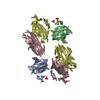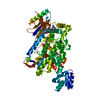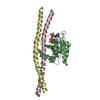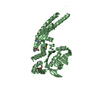[English] 日本語
 Yorodumi
Yorodumi- PDB-1ry7: Crystal Structure of the 3 Ig form of FGFR3c in complex with FGF1 -
+ Open data
Open data
- Basic information
Basic information
| Entry | Database: PDB / ID: 1ry7 | ||||||
|---|---|---|---|---|---|---|---|
| Title | Crystal Structure of the 3 Ig form of FGFR3c in complex with FGF1 | ||||||
 Components Components |
| ||||||
 Keywords Keywords | GROWTH FACTOR/GROWTH FACTOR RECEPTOR / FGF-FGFR Complex / beta trefoil / Ig domain / GROWTH FACTOR-GROWTH FACTOR RECEPTOR COMPLEX | ||||||
| Function / homology |  Function and homology information Function and homology informationt(4;14) translocations of FGFR3 / negative regulation of developmental growth / fibroblast growth factor receptor apoptotic signaling pathway / Signaling by FGFR3 fusions in cancer / bone maturation / chondrocyte proliferation / endochondral bone growth / mesonephric epithelium development / branch elongation involved in ureteric bud branching / regulation of endothelial tube morphogenesis ...t(4;14) translocations of FGFR3 / negative regulation of developmental growth / fibroblast growth factor receptor apoptotic signaling pathway / Signaling by FGFR3 fusions in cancer / bone maturation / chondrocyte proliferation / endochondral bone growth / mesonephric epithelium development / branch elongation involved in ureteric bud branching / regulation of endothelial tube morphogenesis / FGFR3b ligand binding and activation / regulation of endothelial cell chemotaxis to fibroblast growth factor / positive regulation of phospholipase activity / Signaling by activated point mutants of FGFR3 / FGFR3c ligand binding and activation / Phospholipase C-mediated cascade; FGFR3 / FGFR2b ligand binding and activation / fibroblast growth factor receptor binding / FGFR2c ligand binding and activation / Activated point mutants of FGFR2 / Phospholipase C-mediated cascade; FGFR2 / FGFR4 ligand binding and activation / endochondral ossification / FGFR1b ligand binding and activation / Phospholipase C-mediated cascade; FGFR4 / Signaling by activated point mutants of FGFR1 / fibroblast growth factor receptor activity / FGFR1c ligand binding and activation / organ induction / Downstream signaling of activated FGFR1 / Phospholipase C-mediated cascade: FGFR1 / bone morphogenesis / S100 protein binding / positive regulation of tyrosine phosphorylation of STAT protein / Signaling by FGFR2 IIIa TM / PI-3K cascade:FGFR3 / PI-3K cascade:FGFR2 / PI-3K cascade:FGFR4 / PI-3K cascade:FGFR1 / positive regulation of sprouting angiogenesis / bone mineralization / positive regulation of MAP kinase activity / fibroblast growth factor binding / positive regulation of intracellular signal transduction / positive regulation of cell division / PI3K Cascade / fibroblast growth factor receptor signaling pathway / activation of protein kinase B activity / anatomical structure morphogenesis / chondrocyte differentiation / cell surface receptor signaling pathway via JAK-STAT / SHC-mediated cascade:FGFR3 / SHC-mediated cascade:FGFR2 / SHC-mediated cascade:FGFR4 / SHC-mediated cascade:FGFR1 / transport vesicle / FRS-mediated FGFR3 signaling / FRS-mediated FGFR2 signaling / FRS-mediated FGFR4 signaling / Signaling by FGFR3 in disease / FRS-mediated FGFR1 signaling / Signaling by FGFR2 in disease / neurogenesis / Signaling by FGFR1 in disease / extracellular matrix / positive regulation of endothelial cell migration / lung development / regulation of cell migration / epithelial cell proliferation / positive regulation of epithelial cell proliferation / skeletal system development / growth factor activity / Negative regulation of FGFR3 signaling / Negative regulation of FGFR2 signaling / Negative regulation of FGFR4 signaling / wound healing / Negative regulation of FGFR1 signaling / positive regulation of cholesterol biosynthetic process / receptor protein-tyrosine kinase / integrin binding / positive regulation of angiogenesis / Constitutive Signaling by Aberrant PI3K in Cancer / cell-cell signaling / PIP3 activates AKT signaling / MAPK cascade / heparin binding / cellular response to heat / PI5P, PP2A and IER3 Regulate PI3K/AKT Signaling / RAF/MAP kinase cascade / protein tyrosine kinase activity / angiogenesis / cell cortex / positive regulation of ERK1 and ERK2 cascade / positive regulation of phosphatidylinositol 3-kinase/protein kinase B signal transduction / receptor complex / positive regulation of MAPK cascade / positive regulation of cell migration / positive regulation of cell population proliferation / cell surface / endoplasmic reticulum Similarity search - Function | ||||||
| Biological species |  Homo sapiens (human) Homo sapiens (human) | ||||||
| Method |  X-RAY DIFFRACTION / X-RAY DIFFRACTION /  SYNCHROTRON / SYNCHROTRON /  MOLECULAR REPLACEMENT / Resolution: 3.2 Å MOLECULAR REPLACEMENT / Resolution: 3.2 Å | ||||||
 Authors Authors | Olsen, S.K. / Ibrahimi, O.A. / Raucci, A. / Zhang, F. / Eliseenkova, A.V. / Yayon, A. / Basilico, C. / Linhardt, R.J. / Schlessinger, J. / Mohammadi, M. | ||||||
 Citation Citation |  Journal: Proc.Natl.Acad.Sci.Usa / Year: 2004 Journal: Proc.Natl.Acad.Sci.Usa / Year: 2004Title: Insights into the molecular basis for fibroblast growth factor receptor autoinhibition and ligand-binding promiscuity. Authors: Olsen, S.K. / Ibrahimi, O.A. / Raucci, A. / Zhang, F. / Eliseenkova, A.V. / Yayon, A. / Basilico, C. / Linhardt, R.J. / Schlessinger, J. / Mohammadi, M. | ||||||
| History |
|
- Structure visualization
Structure visualization
| Structure viewer | Molecule:  Molmil Molmil Jmol/JSmol Jmol/JSmol |
|---|
- Downloads & links
Downloads & links
- Download
Download
| PDBx/mmCIF format |  1ry7.cif.gz 1ry7.cif.gz | 85.2 KB | Display |  PDBx/mmCIF format PDBx/mmCIF format |
|---|---|---|---|---|
| PDB format |  pdb1ry7.ent.gz pdb1ry7.ent.gz | 62.7 KB | Display |  PDB format PDB format |
| PDBx/mmJSON format |  1ry7.json.gz 1ry7.json.gz | Tree view |  PDBx/mmJSON format PDBx/mmJSON format | |
| Others |  Other downloads Other downloads |
-Validation report
| Summary document |  1ry7_validation.pdf.gz 1ry7_validation.pdf.gz | 440 KB | Display |  wwPDB validaton report wwPDB validaton report |
|---|---|---|---|---|
| Full document |  1ry7_full_validation.pdf.gz 1ry7_full_validation.pdf.gz | 470.4 KB | Display | |
| Data in XML |  1ry7_validation.xml.gz 1ry7_validation.xml.gz | 19 KB | Display | |
| Data in CIF |  1ry7_validation.cif.gz 1ry7_validation.cif.gz | 25.1 KB | Display | |
| Arichive directory |  https://data.pdbj.org/pub/pdb/validation_reports/ry/1ry7 https://data.pdbj.org/pub/pdb/validation_reports/ry/1ry7 ftp://data.pdbj.org/pub/pdb/validation_reports/ry/1ry7 ftp://data.pdbj.org/pub/pdb/validation_reports/ry/1ry7 | HTTPS FTP |
-Related structure data
| Related structure data |  1evtS S: Starting model for refinement |
|---|---|
| Similar structure data |
- Links
Links
- Assembly
Assembly
| Deposited unit | 
| ||||||||||
|---|---|---|---|---|---|---|---|---|---|---|---|
| 1 |
| ||||||||||
| Unit cell |
|
- Components
Components
| #1: Protein | Mass: 17482.697 Da / Num. of mol.: 1 / Fragment: FGF1 Source method: isolated from a genetically manipulated source Source: (gene. exp.)  Homo sapiens (human) / Gene: FGF1 / Production host: Homo sapiens (human) / Gene: FGF1 / Production host:  |
|---|---|
| #2: Protein | Mass: 36294.434 Da / Num. of mol.: 1 / Fragment: FGFR-3c Source method: isolated from a genetically manipulated source Source: (gene. exp.)  Homo sapiens (human) / Gene: FGFR3c / Production host: Homo sapiens (human) / Gene: FGFR3c / Production host:  |
| Has protein modification | Y |
-Experimental details
-Experiment
| Experiment | Method:  X-RAY DIFFRACTION / Number of used crystals: 1 X-RAY DIFFRACTION / Number of used crystals: 1 |
|---|
- Sample preparation
Sample preparation
| Crystal | Density Matthews: 4.3 Å3/Da / Density % sol: 71.4 % | |||||||||||||||||||||||||||||||||||||||||||||||||||||||||||||||
|---|---|---|---|---|---|---|---|---|---|---|---|---|---|---|---|---|---|---|---|---|---|---|---|---|---|---|---|---|---|---|---|---|---|---|---|---|---|---|---|---|---|---|---|---|---|---|---|---|---|---|---|---|---|---|---|---|---|---|---|---|---|---|---|---|
| Crystal grow | Temperature: 293 K / Method: vapor diffusion, hanging drop / pH: 7.5 Details: Peg 4000, glycerol, MPD, cadmium chloride, pH 7.5, VAPOR DIFFUSION, HANGING DROP, temperature 293K | |||||||||||||||||||||||||||||||||||||||||||||||||||||||||||||||
| Crystal grow | *PLUS Temperature: 20 ℃ / Method: vapor diffusion, hanging drop | |||||||||||||||||||||||||||||||||||||||||||||||||||||||||||||||
| Components of the solutions | *PLUS
|
-Data collection
| Diffraction | Mean temperature: 93 K |
|---|---|
| Diffraction source | Source:  SYNCHROTRON / Site: SYNCHROTRON / Site:  NSLS NSLS  / Beamline: X4A / Wavelength: 1.277 / Beamline: X4A / Wavelength: 1.277 |
| Detector | Type: ADSC QUANTUM 4 / Detector: CCD / Date: Jul 3, 2003 |
| Radiation | Monochromator: Kohzu Double Crystal / Protocol: SINGLE WAVELENGTH / Monochromatic (M) / Laue (L): M / Scattering type: x-ray |
| Radiation wavelength | Wavelength: 1.277 Å / Relative weight: 1 |
| Reflection | Resolution: 3.2→30 Å / Num. all: 11404 / Num. obs: 11404 / % possible obs: 98.9 % / Observed criterion σ(F): 0 / Observed criterion σ(I): 0 / Redundancy: 3.68 % / Rsym value: 0.068 / Net I/σ(I): 13.8 |
| Reflection shell | Resolution: 3.2→3.31 Å / Rsym value: 0.303 / % possible all: 95.5 |
| Reflection | *PLUS Highest resolution: 3.2 Å / Lowest resolution: 30 Å / Num. measured all: 41929 / Rmerge(I) obs: 0.068 |
| Reflection shell | *PLUS Highest resolution: 3.2 Å / % possible obs: 95.5 % / Rmerge(I) obs: 0.303 |
- Processing
Processing
| Software |
| ||||||||||||||||||||||||||||
|---|---|---|---|---|---|---|---|---|---|---|---|---|---|---|---|---|---|---|---|---|---|---|---|---|---|---|---|---|---|
| Refinement | Method to determine structure:  MOLECULAR REPLACEMENT MOLECULAR REPLACEMENTStarting model: FGF1-FGFR1c complex (pdb id code 1EVT) Resolution: 3.2→25 Å / Data cutoff high rms absF: 0 / σ(F): 0 / σ(I): 0 / Stereochemistry target values: Engh & Huber
| ||||||||||||||||||||||||||||
| Displacement parameters |
| ||||||||||||||||||||||||||||
| Refinement step | Cycle: LAST / Resolution: 3.2→25 Å
| ||||||||||||||||||||||||||||
| Refine LS restraints |
| ||||||||||||||||||||||||||||
| Refinement | *PLUS Highest resolution: 3.2 Å / Lowest resolution: 25 Å | ||||||||||||||||||||||||||||
| Solvent computation | *PLUS | ||||||||||||||||||||||||||||
| Displacement parameters | *PLUS |
 Movie
Movie Controller
Controller












 PDBj
PDBj





